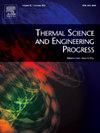高粘度液舱内自然对流换热实验研究
IF 5.1
3区 工程技术
Q2 ENERGY & FUELS
引用次数: 0
摘要
对高粘度流体(重质燃料油)的船舶货舱进行了自然对流换热实验研究。货舱被建模为1/20比例的矩形封闭体积。封闭体积内的流体通过电阻丝从底板加热,通过循环恒温水浴从顶板冷却。底板和顶板采用等温边界条件。矩形封闭体的所有其他边界都是绝缘的。甘油被用作封闭体积内的工作流体来模拟重质燃料油粘度随温度的大变化。实验研究了底板与顶板温差对自然对流换热及封闭体内温度场的影响。在三种不同的温差(ΔTp = TH−TC)下进行了实验,瑞利(Ra)数在1.43 × 108 ~ 6.57 × 108之间变化。Prandtl (Pr)数在1633.9≤Pr≤3612.1范围内变化。给出了封闭体内的温度分布,并计算了平均努塞尔(Nu)值。平均Nu值随着ΔTp的增大而增大。相反,系统稳定所需的时间与ΔTp值成反比。研究了高黏度流体的自然对流特性,建立了Nu数和Ra数之间的实验关系。本文章由计算机程序翻译,如有差异,请以英文原文为准。
Experimental investigation of natural convection heat transfer in a ship cargo tank filled with high-viscosity fluid
Experimental research was conducted to elucidate heat transfer by natural convection in a ship cargo tank filled with high-viscosity fluid (heavy fuel oil). The cargo tank was modeled as a 1/20 scale rectangular enclosed volume. The fluid in the enclosed volume was heated from the bottom plate by resistance wires and cooled from the top plate using a circulating thermostatic water bath. The isothermal boundary condition was used for the bottom and top plates. All other boundaries of the rectangular enclosed volume were insulated. Glycerin was used as a working fluid in the enclosed volume to model the large temperature-dependent variation in the viscosity of heavy fuel oil. The effects of the temperature difference between the bottom plate (TH) and top plate (TC) on the heat transfer by natural convection and the temperature field in the enclosed volume were experimentally investigated. Experiments were conducted for three different temperature differences (ΔTp = TH − TC) and the Rayleigh (Ra) number was varied between 1.43 x 108 and 6.57 x 108. The Prandtl (Pr) number was varied in the range of 1633.9 ≤ Pr ≤ 3612.1. The temperature profiles in the enclosed volume are presented and the mean Nusselt (Nu) values are calculated. The mean Nu value increased as the ΔTp increased. In contrast, the time required for the system to stabilize is inversely related to the ΔTp value. The natural convection characteristics in a tank filled with high-viscosity fluid were obtained and an experimental correlation between the Nu and Ra numbers was developed.
求助全文
通过发布文献求助,成功后即可免费获取论文全文。
去求助
来源期刊

Thermal Science and Engineering Progress
Chemical Engineering-Fluid Flow and Transfer Processes
CiteScore
7.20
自引率
10.40%
发文量
327
审稿时长
41 days
期刊介绍:
Thermal Science and Engineering Progress (TSEP) publishes original, high-quality research articles that span activities ranging from fundamental scientific research and discussion of the more controversial thermodynamic theories, to developments in thermal engineering that are in many instances examples of the way scientists and engineers are addressing the challenges facing a growing population – smart cities and global warming – maximising thermodynamic efficiencies and minimising all heat losses. It is intended that these will be of current relevance and interest to industry, academia and other practitioners. It is evident that many specialised journals in thermal and, to some extent, in fluid disciplines tend to focus on topics that can be classified as fundamental in nature, or are ‘applied’ and near-market. Thermal Science and Engineering Progress will bridge the gap between these two areas, allowing authors to make an easy choice, should they or a journal editor feel that their papers are ‘out of scope’ when considering other journals. The range of topics covered by Thermal Science and Engineering Progress addresses the rapid rate of development being made in thermal transfer processes as they affect traditional fields, and important growth in the topical research areas of aerospace, thermal biological and medical systems, electronics and nano-technologies, renewable energy systems, food production (including agriculture), and the need to minimise man-made thermal impacts on climate change. Review articles on appropriate topics for TSEP are encouraged, although until TSEP is fully established, these will be limited in number. Before submitting such articles, please contact one of the Editors, or a member of the Editorial Advisory Board with an outline of your proposal and your expertise in the area of your review.
 求助内容:
求助内容: 应助结果提醒方式:
应助结果提醒方式:


